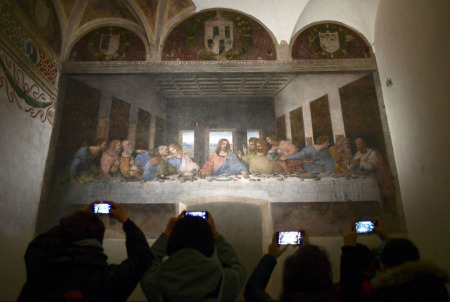Leonardo da Vinci’s ‘quick eye’: Developing your God-given talents

The Mona Lisa is the world’s most famous painting, which makes Leonardo da Vinci the world’s most famous painter. Now we learn that he may have possessed a genetic advantage common to some baseball players and tennis stars.
David Thaler is a geneticist at the University of Basel in Switzerland. He has been studying higher flicker fusion frequency, a trait he calls “quick eye.”
He believes that some people have this capacity as the result of genes that govern the development of the potassium channels in the cells of the retina. It enables them to see what the rest of us cannot, such as the seams of a baseball in flight or the trajectory of a tennis ball.
In his view, Leonardo’s ability to capture the Mona Lisa’s enigmatic half-smile is evidence of this ability. Her smile does not seem posed and held steady. Rather, Thaler notes that the artist captured the “passing instant when the smile is in the act of becoming.”
Thaler was first inspired to investigate Leonardo’s vision by a comment the artist made in one of his notebooks on the flight of dragonflies. “The dragonfly flies with four wings, and when those in front are raised those behind are lowered,” he noted.
However, as Thaler discovered, the insect’s front wings are out of sync with its back wings by only a hundredth of a second. This corresponds to a flicker fusion frequency of 100 hertz (100 times a second), which is roughly twice the flicker fusion frequency of most humans.
Thaler notes that Leonardo’s painting of The Last Supper also captures the fleeting expressions of the apostles after Jesus told them that one of them would betray him.
Finding and developing your uniqueness
Reading about Leonardo’s “quick eye” makes me feel better about my artistic limitations. My most significant achievement in the world of painting is a paint-by-numbers depiction of a ship at sea I created as a child. If I were attempting to make a living by painting, I would bring new meaning to “starving artist.”
I also remember the time in college I tried to hit a baseball pitched at major league speed. It was in a batting cage; I inserted my quarters and took my stance in the batter’s box. I watched the arm of the pitching machine rotate to its release point, then I heard the ball hit the fencing behind me. I never saw it.
But the fact that I obviously do not have a “quick eye” does not exempt me from discovering, developing, and utilizing the gifts and abilities I do have. Like Leonardo da Vinci, each of us was created uniquely by our omniscient Father. Our abilities, education, experiences, and spiritual gifts as Christians are combined in a way common to no one else.
The key is to develop our uniqueness to its fullest capacity and then to use it fully for the glory of God. The good news is that the Holy Spirit stands ready to empower us in this quest and to help us fulfill our purpose. As with Paul and Barnabas, he has a “work” to which he has called us (Acts 13:2). In these difficult and divisive days, our culture desperately needs the salt and light we alone can bring (Matthew 5:13–16).
Oswald Chambers’ mantra should be ours: “My utmost for his highest.” Our question every day should be: am I being my best for my Lord today?
Are you?
This piece was originally published at the Denison Forum





















